|

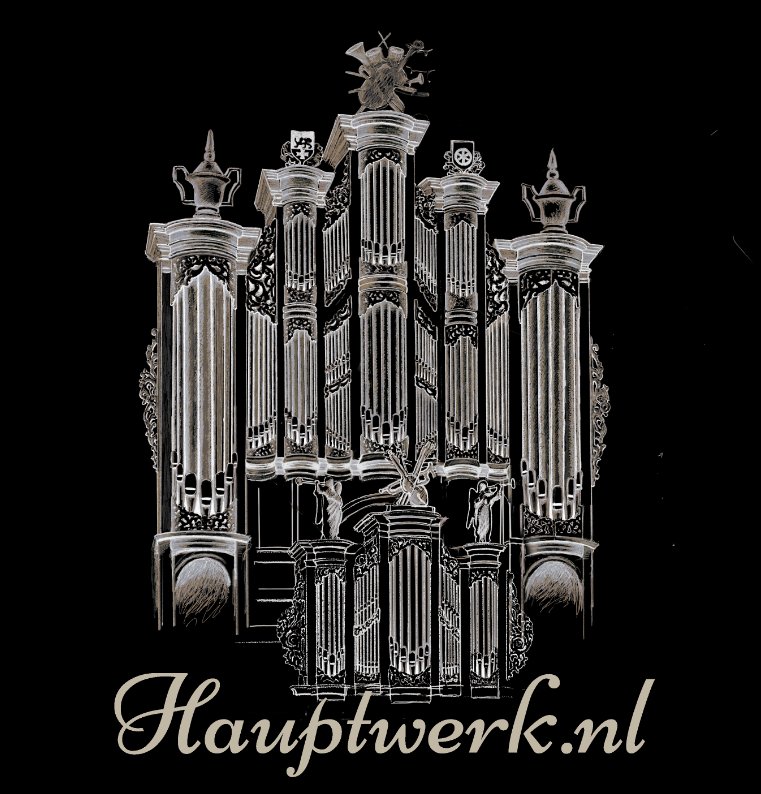







|
|
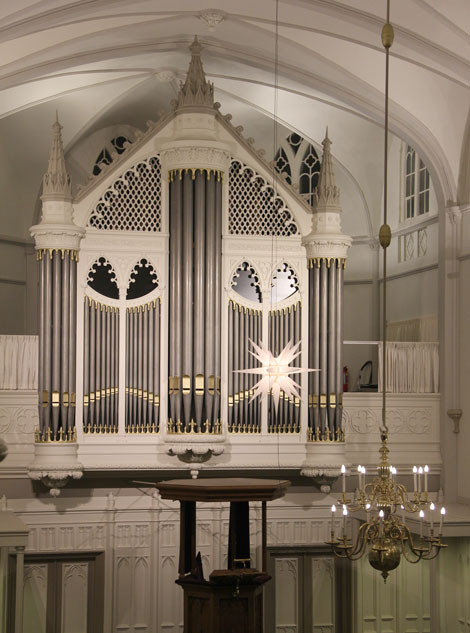
The organ front
Picture Willem den Boer H.I. Ambacht
|
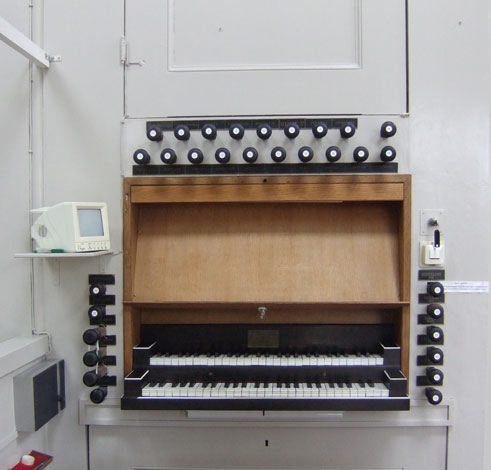
Console
Picture Willem den Boer H.I. Ambacht
|
|
1. The Bätz-organ (1843):
|
|
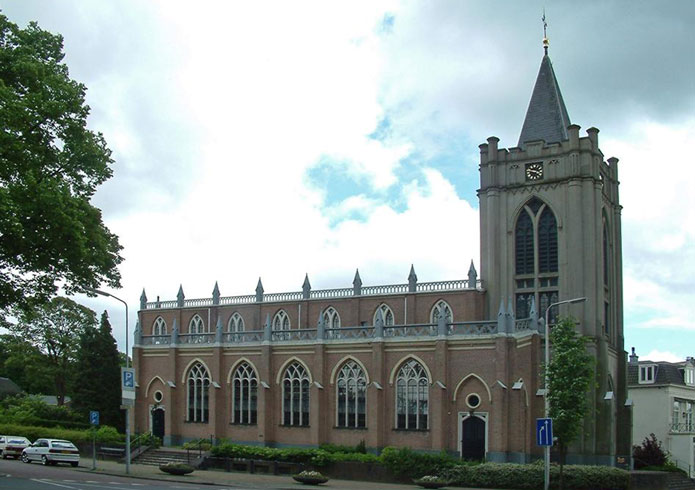
The church
Picture Willem den Boer H.I. Ambacht
|
In 1821 the Oude Kerk received its first organ, built by the organ builder J.F. Friedrichs who made use,
among other things, of the organ the Joh. Baars had built in 1779 for the Walloon church in Naarden.
When completed in 1821, the organ had the following disposition:
Hoofdwerk: Prestant 8', Roerfluit 8', Octaaf 4', Nachthoorn 4', Quint 3', Octaaf 2', Cornet disc, Dulciaan 8'
Bovenwerk: Roerfluit 8', Viola di Gamba 8', Salicionaal 4', Fluit 4', Gemshoorn 2'
Pedaal: Attached
Couplers: Hoofdwerk-Bovenwerk, Pedaal-Hoofdwerk. Tremulant on the bovenwerk.
Manual Compass: C-f''', Pedal Compass: C-D'. Temperament: Equal. Pitch Level: a'=440 Hz.´
Bovenwerk: Roerfluit 8´ , Viola di Gamba 8´ , Salicionaal 4´ , Fluit 4´ , Gemshoorn 2´
Pedaal: Fixed
Coupler: Hoofdwerk-Bovenwerk, Pedaal-Hoofdwerk. Tremulant on bovenwerk.
Compass: C-f´ ´ ´ , Pedal compass: C-D´ . Tuning: Equal. Pitch: a´ =440 Hz.
The New Organ:
With construction of the current church, it was eventually decided to also build a new organ and in the
same Gothic Revival style of the new church. Artistically this turned out to be a fortunate choice.
The organ, built by the organ builder Batz, was put into use on November 5, 1843.
In 1909, De Koff placed the bovenwerk inside a swell enclosure and replaced the Gemshorn 2' with a
Voix Celeste 8' and the Trombone 8' with a Fagot 16'.
In 1977, Verschueren restored/conserved the organ using 1843 as starting point.
Text with permission taken from website www.hervormdzeist.nl
www.hervormdzeist.nl
|
|
2. The disposition: ( + added for Hauptwerk.)
|
Manual I: Hoofdwerk
C-f3 (Hauptwerk g3)
|
Manual II: Zwelwerk
C-f3 (Hauptwerk g3)
|
Pedals: C-d1 (Hauptwerk f1)
|
Playing Aids:
|
01-Prestant
02-Praestant
03-Roerfluit
04-Octaaf
05-Fluit
06-Quint
07-Octaaf
08-Cornet
09-Mixtuur
10-Fagot
11-Trompet
|
16'
8'
8'
4'
4'
3' (2 2/3')
2'
5 ranks (Disc.)
3 - 5 ranks
16' +
8' Bas/Disc
|
|
12-Vioolprestant
13-Holpijp
14-Viola di Gamba
15-Vox Celeste
16-Salicionaal
17-Fluit
18-Quint
19-Gemshoorn
20-Tertsfluit
21-Schalmei
22-Dulciaan
|
8'
8'
8'
8' +
4'
4'
3' (2 2/3')
2'
1 3/5' +
8' +
8'
|
|
23-Prestant
24-Subbas
25-Octaafbas
26-Fluitbas
27-Octaaf
28-Fagot
29-Trombone
|
16' +
16'
8'
8'
4'
16'
8' +
|
|
Coupler Pedaal - Hoofdwerk
Coupler Pedaal - Zwelwerk
Manual coupler
Tremulant - Zwelwerk
Tremulant - Zwelwerk
(Modulated) +
Tremulant - Hoofdwerk
(Modulated) +
Calcant (Motor-switch)
Ventiel (vertil)
Zweltrede - Zwelwerk
Afsluiting (shutoff) - Hoofdwerk (not in Hauptwerk)
Afsluiting (shutoff) - Rugwerk (not in Hauptwerk)
Afsluiting (shutoff) - Pedaal (not in Hauptwerk)
|
|
|
3. Technical information:
|
Windpressure: 70 mm (2.76 inch WC)
Tuning: a' = ca. 434 Hz.
Temperament: Equal (Of course in Hauptwerk this can be switched to another temperament)
Tremulants
On the real organ is no tremulant for the Hoofdwerk provided. We have added one for Hauptwerk.
The tremulant for the Zwelwerk is duplicated: 1st: Integral recorded and 2nd: Modulated.
Not everyone likes the original tremulant, in this case you can then choose the modulated tremulant and as usual
change everything including speed and depth.
|
This sample set was recorded from three positions in stereo (24 bit 96kHz).
The set comes with a Sygsoft devised 3-channel technique whereby the user may set the listening position themselves.
There are 3 positions, namely :
1: Front, recorded very close to the organ. This provides a very direct recording that is useful for study purposes.
2: Centre (Middle), this recording was made at about 3 times the distance used in the front recording.
3: Rear, recorded far from the organ is used as surround.
Through three sliders (0-100%), a mix can be made of the three positions that is to your liking.
The 4th slider (with the caption "Vol-ZW") is definitely not a swell pedal but a volume control for the entire Zwelwerk.
Using the button "R" switches it back to the normal volume.
The 5th slider controls the Swell.
While the pedals are not visible we have on the black tab below the Hoofdwerk LED's mounted to show wich key is pressed.
The adjacent picture is a representation of the original console. All extensions we have placed on the "Advanced" tab also
more suited to touchscreen users. For more see the Consoles page.
|
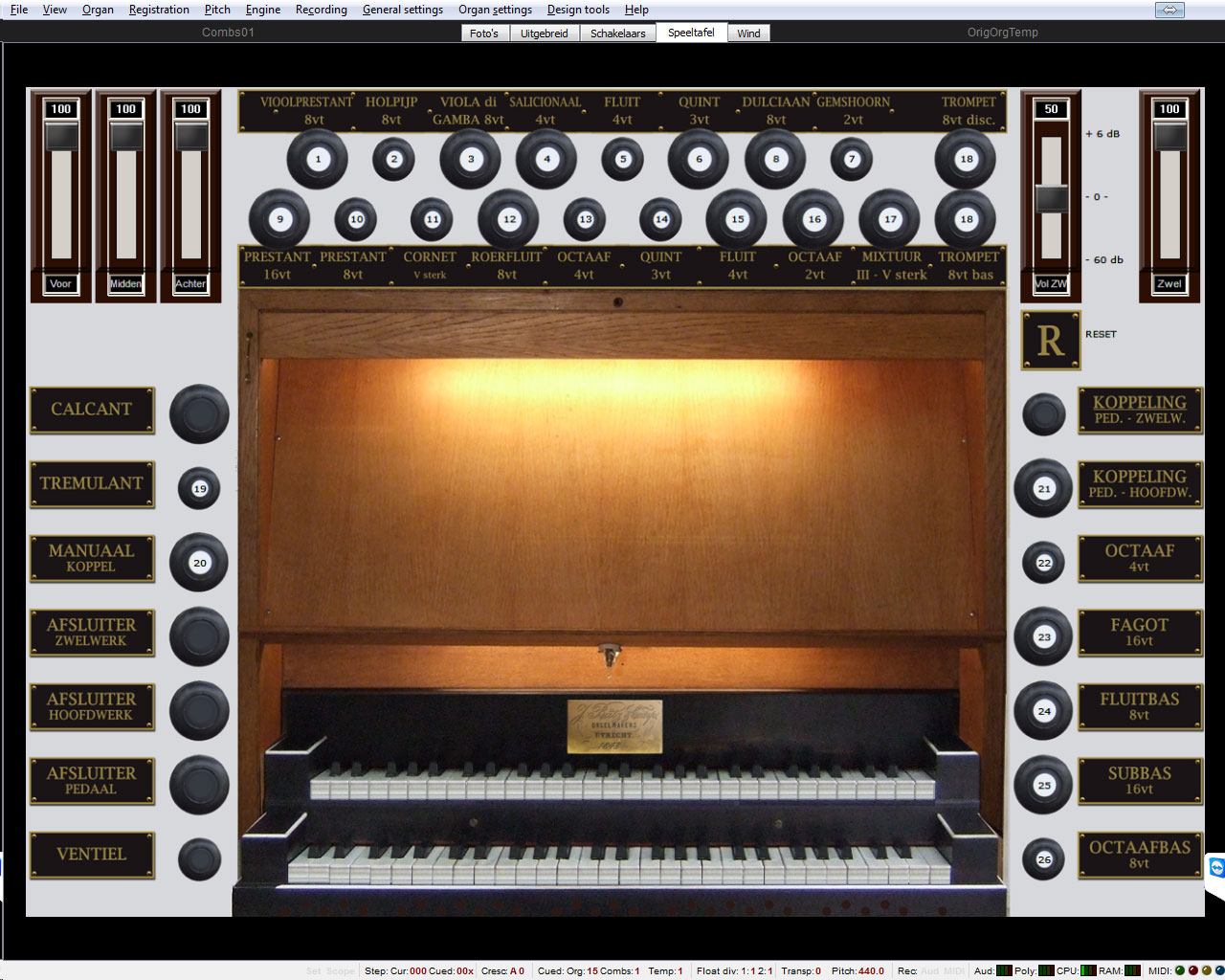
Virtual console (original)
|
The recordings for this sample set were made in Februari 2014.
Recording quality 96 kHz, 24 bit. The set is reduced to 48 kHz 24 bit.
Number of microphones: 6.
Number of samples processed in this set: 25,219
Number of files in this set 26,227 in 573 mappen.
Number of samples per pipe Hoofdwerk: 14
Number of samples per pipe Pedaal: 12
Number of samples per pipe Zwelwerk: 20
Number of lines in the Organ Definition File: appr. 1.355.000
Division of the Work:
Christian Boogaard: Noise reduction, demos and artistic advice.
Johan van der Waal van Dijk: processing of samples and technical advice.
Fred de Jong: Layout, ODF as well as customizing the website and general management.
Thanks go to the organist Martin den Boer for contacts and advice,
and to Cris van Wijk en dhr. van Randewijk who as church warden were responsible for granting permission for recording.
Fred de Jong December 2016.
|
|
|
|
